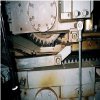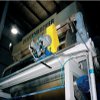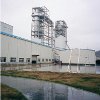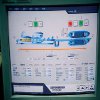Fast track at Lishui Oak
26 March 2010Asmall, government-owned sawmill beside the Oujiang river in Lishui, Zhejiang Province, formed the foundation for the Lishui Oak company in the early 1980s.
In the middle of that decade, it turned its attention to the panel industry with the construction of a wet-process fibreboard (hardboard) line.
In 1988, changes were made to that line to turn it into a dry process fibreboard (MDF) facility, equipped with a Chinesemade multi-opening press.
A second MDF line, from Shanghai Wood Based Panel Machinery Co Ltd (SWBPMC), followed in the mid-90s.
“After two or three years, this line was running well; and the MDF industry was growing fast,recalled the general manager of Lishui’s new continuous Dieffenbacher line, Mr Wang Guoshu. “Thus, in 1998, we started to build another four lines, two in Zhejiang Province and two in Fujian. These were again multi-opening lines from SWBPMC.
“In around 2000, we built another three multi-opening lines in Fujian Province and, in 2002, another similar line in Guangzhou, Guangdong Province.
“Then, in June 2002, we signed the contract with Dieffenbacher for our first continuous press line for MDF.”
The first board from this line was produced on August 5, 2003, the company having built a complete new factory on a 150,000m2 greenfield site on the outskirts of Lishui city in just over a year. This was in spite of the fact that a lot of rock had to be brought in, and piles driven, on this lowlying site close to the river.
However, this is not the latest line for the company; also in 2003, it started up another multi-opening line from SWBPMC, with locally made chipping equipment and an Andritz refiner. This time the line was located in Shanghai. The wood raw material for this line is waste wood from the greater Shanghai area and Mr Wang believes his company was the first to use such material to make MDF in China.
During this period of rapid development, the company also became privately owned by a group of investors in 1993, of which the principle shareholder is company chairman Mr Xu Meng Zhang.
The whole Lishui continuous line project was split into six contracts, with Dieffenbacher supplying everything from the dryer to the finishing line, GTS Energy of America the energy generation plant, Andritz the refiner, Steinemann the sander and Anthon the cut-to-size system. On-the line quality control and spark detection/ extinguishing systems were from GreCon.
In fact, at the time of my visit in early March, the GreCon system had stopped a fire the previous night, with the factory and line sustaining no damage.
Dieffenbacher also had the overall responsibility for coordinating all the plant suppliers for the line.
The 50,000m2 log yard holds the stock of raw material, which is about 60% Mason pine and 40% hardwood, including beech and eucalyptus among other species, all in log form from local plantations. “We do not use bought-in chips because we cannot control the quality,explained Mr Wang.
Chipping was supplied by Andritz Oy of Finland which also designed the debarker, although it was manufactured in China.
The Schenkmann & Piel-designed dryer is followed by a sifter from the same division of Dieffenbacher. The GTS Energy system was the first such line in China and Mr Wang had experience of this system from West Pine’s mill in Canada.
Mr Wang designed and built the gluing system himself. As in so many other areas of the factory, he called on his eight years’ experience with PTP, beginning under the expert guidance of Norman Lau.
The Dieffenbacher forming station is the latest generation with a fibre distribution and classification system integrated into the main fibre stream to dissolve fibre knots and improve spreading accuracy. It is also claimed to reduce operating costs through lower exhaust air volumes and to give a faster response in terms of weight control with changing wood types. This mechanical head enables the production of boards down to 2mm thickness.
The company plans to install an equalising roller system on the former to calibrate the fibre mat prior to pre-pressing in the multi-nip belt pre-press, when time permits. This will then remove the need for scalping and the attendant suction which Mr Wang says removes the smaller fibres from the top surface of the mat, and not the bottom, leading to imbalance in the board and to fibre sticking to the press belt.
Meanwhile, measuring and scanning equipment in the forming line allows continuous monitoring of mat and fibre quality as it approaches the 23.2m, 17 frame, CPS continuous press. This includes a GreCon density analyser. That press is also the latest generation, with adjustable/flexible, high-speed infeed to cater for the fact that the majority of Lishui’s production is thin board.
“Dieffenbacher is a good supplier,said Mr Wang. “They make modifications to their plant as required, very efficiently, according to experience of the lines in operation.The press is designed to run at up to 1,000mm per second and Lishui already had it running at 950mm per second, six months after start-up. For four to five millimetre board, that equates to over 600m3 a day, according to Mr Wang.
The design capacity of the line was 150,000m3 but he said that he had already made his own modifications to the front end during construction to raise total capacity to 180,000m3 a year.
At the press infeed, there are traversing polishing belts to clean the Sandvik-supplied 2.7mm stainless steel belts of the press, top and bottom.
The spacious control room is equipped with conventional monitors and controls for the entire production line, with Dieffenbacher Proguide system, as well as CCTV monitoring. The quality control laboratory is equipped with GreCon measuring and analysing systems. Lishui Oak also has a Sandvik belt patching tool for repairs to the press belts.
After the star cooler, packs are handled by fork lift for transfer to intermediate storage, to the Steinemann six-head Satos sander and Anthon cut-to-size plant, and to the 10,000m2 storage area.
Currently, Lishui Oak only produces raw board, but the company does have its eye on value adding for the future. “We are discussing which market is best for value adding,said Mr Wang. “We may go for furniture production or some form of value adding to the panel itself.”
Laminate flooring is not one of the value adding options being considered. “The price for laminate flooring is very poor and the quality is generally poor as many manufacturers are producing the board on multi opening lines,said the general manager. “The price has fallen from around RMB3,000 (US$363.6) to around RMB2,000 per m3, but at 880kg/m3 density. It is not a product we would consider making. There are too many small manufacturers who do not care about the quality – some do not even use a wear-resistant overlay.”
So far, the company’s markets for its raw board have been domestic, mainly in Guangzhou, Fujian, Zhejiang, Shanghai and Jiangsu, but with some production also going to Beijing and Chengdu regions. It has no export business yet but is talking to potential customers in Japan and Malaysia.
“We are already producing to E0, E1 and E2 grades by modifications to the resin recipe, using urea formaldehyde and melamine urea formaldehyde resins, and we add more wax to produce a moisture-resistant grade,said Mr Wang.
Asked whether Lishui Oak was considering adding another line to its tally of 11, Mr Wang said: “Not yet. We will increase our capacity in the future, but this line has only just started. When we are well-established, we will think about expansion.”



